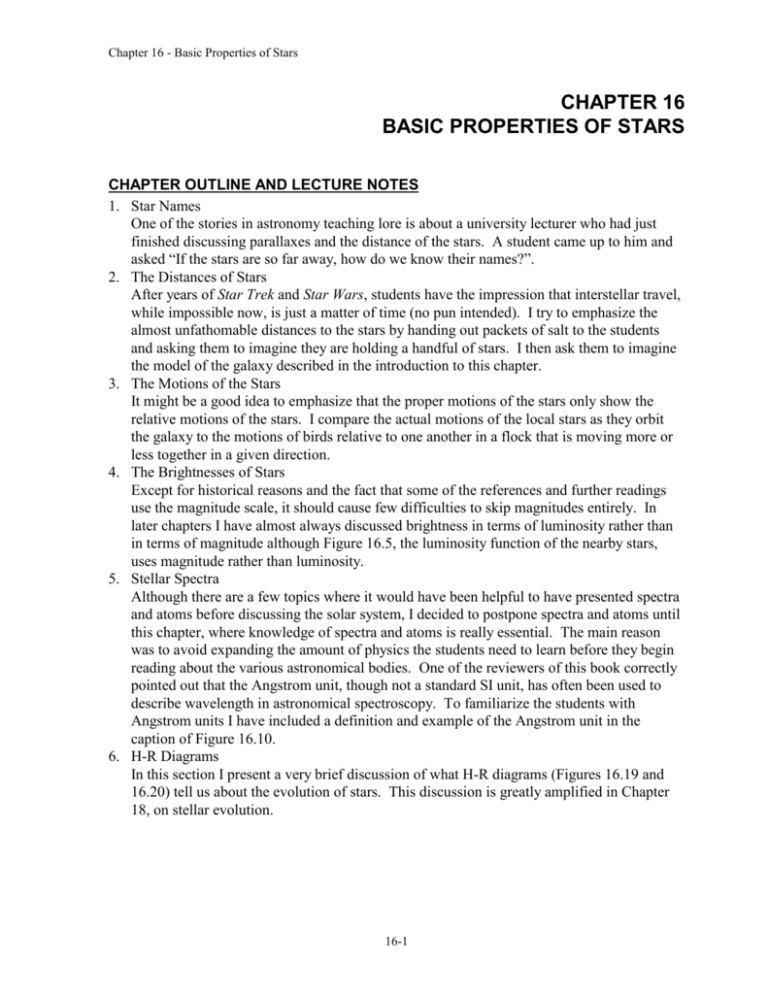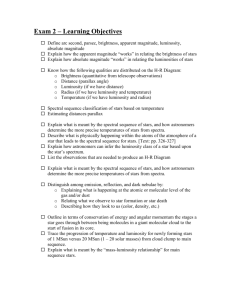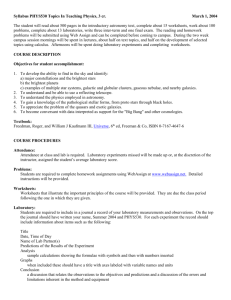Chapter16
advertisement

Chapter 16 - Basic Properties of Stars CHAPTER 16 BASIC PROPERTIES OF STARS CHAPTER OUTLINE AND LECTURE NOTES 1. Star Names One of the stories in astronomy teaching lore is about a university lecturer who had just finished discussing parallaxes and the distance of the stars. A student came up to him and asked “If the stars are so far away, how do we know their names?”. 2. The Distances of Stars After years of Star Trek and Star Wars, students have the impression that interstellar travel, while impossible now, is just a matter of time (no pun intended). I try to emphasize the almost unfathomable distances to the stars by handing out packets of salt to the students and asking them to imagine they are holding a handful of stars. I then ask them to imagine the model of the galaxy described in the introduction to this chapter. 3. The Motions of the Stars It might be a good idea to emphasize that the proper motions of the stars only show the relative motions of the stars. I compare the actual motions of the local stars as they orbit the galaxy to the motions of birds relative to one another in a flock that is moving more or less together in a given direction. 4. The Brightnesses of Stars Except for historical reasons and the fact that some of the references and further readings use the magnitude scale, it should cause few difficulties to skip magnitudes entirely. In later chapters I have almost always discussed brightness in terms of luminosity rather than in terms of magnitude although Figure 16.5, the luminosity function of the nearby stars, uses magnitude rather than luminosity. 5. Stellar Spectra Although there are a few topics where it would have been helpful to have presented spectra and atoms before discussing the solar system, I decided to postpone spectra and atoms until this chapter, where knowledge of spectra and atoms is really essential. The main reason was to avoid expanding the amount of physics the students need to learn before they begin reading about the various astronomical bodies. One of the reviewers of this book correctly pointed out that the Angstrom unit, though not a standard SI unit, has often been used to describe wavelength in astronomical spectroscopy. To familiarize the students with Angstrom units I have included a definition and example of the Angstrom unit in the caption of Figure 16.10. 6. H-R Diagrams In this section I present a very brief discussion of what H-R diagrams (Figures 16.19 and 16.20) tell us about the evolution of stars. This discussion is greatly amplified in Chapter 18, on stellar evolution. 16-1 Chapter 16 - Basic Properties of Stars 7. Stellar Masses Some of your students (certainly some of mine) may have trouble with non-integer exponents such as those in the mass-luminosity relation (Figure 16.21). A reminder of the meaning of non-integer exponents might be a good idea. Even if they have trouble with the concept, however, they should be able to use most calculators to do problems involving the use of non-integer exponents. KEY TERMS absolute magnitude — The apparent magnitude a star would have if it were at a distance of 10 parsecs. absorption line — A dark line superimposed on a continuous spectrum when a gas absorbs light from a continuous source that is hotter than the absorbing gas. antapex — The direction in the sky away from which the Sun is moving. Because of the Sun’s motion, nearby stars appear to converge toward the antapex. apex — The direction in the sky toward which the Sun is moving. Because of the Sun’s motion, nearby stars appear to diverge from the apex. apparent brightness — The observed brightness of a celestial body. apparent magnitude — The observed magnitude of a celestial body. Balmer series — A series of absorption or emission lines of hydrogen seen in the visible part of the spectrum. brown dwarf — A star with too low a mass for nuclear fusion to begin in its core. continuous spectrum — A spectrum containing neither emission nor absorption lines. dwarf — A main sequence star. emission line — A narrow, bright region of the spectrum. Emission lines are produced when electrons in atoms jump from one energy level to a lower energy level. energy level — Any of the many energy states that an atom may have. Different energy levels correspond to different distances of the electron from the nucleus. giant — A star larger and more luminous than a main sequence star (dwarf) of the same temperature and spectral type. ground state — The lowest energy level of an atom. Hertzsprung-Russell diagram (H-R diagram) — A plot of luminosities of stars against their temperatures. Magnitude may be used in place of luminosity and spectral type in place of temperature. ionization — The removal of one or more electrons from an atom. Kirchhoff’s laws — Three “laws” that describe how continuous, bright line, and dark line spectra are produced. light year — The distance that light travels in a year. luminosity — The rate of total radiant energy output of a body. luminosity class — The classification of a star’s spectrum according to luminosity for a given spectral type. Luminosity class ranges from I for a supergiant to V for a dwarf (main sequence star). luminosity function — The distribution of stars or galaxies according to their luminosities. A luminosity function is often expressed as the number of objects per unit volume of space that are brighter than a given absolute magnitude or luminosity. 16-2 Chapter 16 - Basic Properties of Stars Lyman series — A series of absorption or emission lines of hydrogen lying in the ultraviolet part of the spectrum. magnitude — A number, based on a logarithmic scale, used to describe the brightness of a star or other luminous body. Apparent magnitude describes the brightness of a star as we see it. Absolute magnitude describes the intrinsic brightness of a star. main sequence — The region in an H-R diagram occupied by stars that are fusing hydrogen into helium in their cores. The main sequence runs from hot, luminous stars to cool, dim stars. mass–luminosity relation — The relationship between luminosity and mass for stars. More massive stars have greater luminosities. parsec — The distance at which a star has a parallax of 1 second of arc. At a distance of 1 parsec, an AU fills an angle of 1 second of arc. proper motion — The rate at which a star appears to move across the celestial sphere with respect to very distant objects. radial velocity — The part of the velocity of a body that is directed toward or away from an observer. The radial velocity of a body can be determined by the Doppler shift of its spectral lines. solar motion — The motion of the Sun with respect to the nearby stars. spectral class — A categorization, based on the pattern of spectral lines of stars, that groups stars according to their surface temperatures. supergiant — An extremely luminous star of large size and mass. white dwarf — A small, dense star that is supported against gravity by the degenerate pressure of its electrons. ANSWERS TO QUESTIONS AND PROBLEMS Conceptual Questions 1. Because Sirius is brighter than Newton assumed it was, it must be more distant than he calculated to have the apparent brightness it does. 2. Parallax shifts the direction of a star back and forth. Proper motion moves the star progressively farther with time. 3. The directions of the apex and antapex would stay the same. Nearby stars would have larger proper motions because their directions relative to the Sun would change at a greater rate. Suppose the two stars travel the same distance through space relative to the Sun. The nearer star will move through a greater angle than the more distant star. 4. The photon absorbed when an atom moves from energy level A to energy level B has the same energy and wavelength as the photon emitted when the atom moves from level B back to level A. 5. For emission to occur, the electron must jump to a lower energy level. An electron in the ground state can’t jump to a lower level. 6. The reader must supply his or her own answer. 7. Essentially all the hydrogen in an O star is in ionized rather than atomic form and only hydrogen atoms can produce Balmer lines. In the cooler A star, there is more atomic hydrogen. 16-3 Chapter 16 - Basic Properties of Stars 8. The gas in the atmosphere of the G star is too cool for collisions to excite many hydrogen atoms to the second energy level from which Balmer absorption must occur. In the hotter A star more hydrogen is excited to the second energy level. 9. The radial velocity is 0 km/s. 10. (b) 11. Most stars spend most of their luminous lifetimes as main sequence stars. 12. The giant is brighter. Problems 1. 0.025 seconds of arc 2. 5 parsecs 3. 37 years 4. 0.8 second of arc, 0.008 seconds of arc 5. 40 times as bright 6. 630 times as bright 7. 2.5 million times as bright 8. Star A is 250 times as bright 9. 4 magnitudes 10. 1600 11. 17 12. 1 parsec 13. 500.33 nm 14. 1330 km/s toward the Earth 15. The more massive star is 130 times as luminous Figure-Based Questions 1. The energy of the Lyman line is less than the energy of the Lyman line, so the wavelength of the Lyman line is longer. 2. There are about one-quarter as many stars of absolute magnitude 6. 3. The energy of the Lyman line is the same as the combined energies of the Lyman and Balmer lines, so, because the energy of a photon is proportional to its frequency, the frequency of the Lyman line is equal to the sum of the frequencies of the Lyman and Balmer lines. 4. The abundance of tin is about 1/1000 that of iron. 5. About 0.005, about 400 16-4








